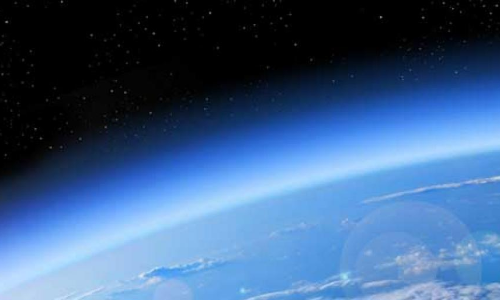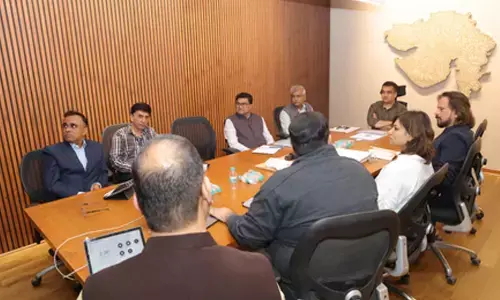Understanding ozone layer and associated concepts

The population of vertebrate species on Earth in the wild saw a dramatic fall of about 30% between 1970 and 2006, with the worst effects being in the tropics and in freshwater ecosystems. Destruction of species’ habitats by pollutants and land-use change are destroying flora and fauna at unprecedented rates. ozone layer, Understanding ozone layer
The population of vertebrate species on Earth in the wild saw a dramatic fall of about 30% between 1970 and 2006, with the worst effects being in the tropics and in freshwater ecosystems. Destruction of species’ habitats by pollutants and land-use change are destroying flora and fauna at unprecedented rates.
In fact, the ecological footprint of humanity — the natural habitats, such as water and land, transformed or destroyed as a result of human activity — far exceeds the biological capacity of the earth.
Identifying and quantifying planetary boundaries that must not be transgressed could help prevent human activities from causing unacceptable environmental change.
What is Ecological footprint of humanity and Biocapacity?
- The ecological footprint measures human demand on nature, i.e., the quantity of nature it takes to support people or an economy
- It is a measure of human impact on Earth’s ecosystemand reveals the dependence of the human economy on natural capital.
- The ecological footprint is defined as the biologically productive area needed to provide for everything people use: fruits and vegetables, fish, wood, fibres, absorption of carbon dioxide from fossil fuel use, and space for buildings and roads.
- Biocapacity is the productive area that can regenerate what people demand from nature.
- Ecological footprint and biocapacity can be compared at the individual, regional, national or global scale.
- Both footprint and biocapacity change every year with number of people, per person consumption, efficiency of production, and productivity of ecosystems.
- Ecological footprint analysis is widely used around the Earth in support of sustainabilityassessments.
- From 1961 to 2010, Ecological Footprint accounts indicate that human demand for renewable resources and ecological services reaching a point where the planet’s bio productive area is no longer sufficient to support the competing demands.
Climate change
- Climate change is one of the most significant topics that needs to be discussed today; not just the whys and hows but also what can be done to minimize the harmful implications from this phenomenon.
- Methane, water vapour, CFCs (chlorofluorocarbons) and Carbon Dioxides constitute the major greenhouse gases. Pollution today, be it from industries, vehicles have shot up the concentration of Greenhouse Gases beyond what is desirable, or which is healthy. Naturally, this tempers with the balance that needs to be maintained, resulting in adverse weather conditions across the globe and making people suffer.
Ozone layer
- It is created in the upper atmosphere by the action of solar radiation on oxygen molecules.
- As far as its position is concerned, it is found in the form of a thin layer in the stratosphere between 15 to 48 kilometre.
- Ozone constitutes only less than 0.002 percent of the volume of the atmosphere.
- About 90% of all atmospheric ozone is found in this layer.
- It strongly absorbs ultraviolet radiation from the sun.
- Ultraviolet radiation is biologically destructive in many ways.
- It causes skin cancer and cataracts, suppresses the human immune system, dimimshes the yield of many crops, disrupts the acquatic food chain by killing micro-organisms on the ocean surface and many other negative effects which is still undiscovered.
- This is happening due to certain recent human activities which have injected certain chemicals in the stratosphere which consume ozone and reduce its concentration.
- Depletion is mainly caused by chlorofluorocarbons (CFCs), halons, methyl chloroform and carbon tetrachloride.
Ozone depleting substances
- These chemical substances are mainly either chlorine or brominewhich can reach the stratosphere and catalytically break down ozone into oxygen.
- CFCs are odourless, non-flamable, non-corosive and nontoxic.
- For this reason, scientist originally believed CFCs could not possibly have any effect on the environment.
- That is why it is widely used in refrigeration and air conditioning, in foam and plastic manufacturing and in aerosol sprays.
- Not only is the ozone layer thinning, in some places it has temporarily disappeared.
- A hole in the layer has developed over Antarctic since 1979 and that hole has persisted for a longer and longer time every year.
- In 1988, an ozone hole was found over the Arctic for the first time and it too has lasted longer and longer each year since then.
Ozone depletion
- Ozone Layer is very crucial for the existence of mankind, since it does not allow ultra violet rays from the sun to reach earth’s atmosphere.
- This layer is located around 15-30 km above the surface. However, since quite some time people have been doing things and using products that have depleted this ozone layer, with harmful consequences of course.
- And this layer seems to be getting worse, thanks to the self destructing activities of materialistic human beings.
- This has started ever since towards the end of 20th century. These chemicals have been used in ACs, refrigerators, and various other electronic equipments and different agricultural solvents.
- Ozone depletion has been grabbing headlines of late and is considered as an international issue.
- The degree of depletion however is not the same and varies by region.
- The minimum depletion has occurred in the tropics and the most eyebrow raising situation of ozone depletion has been in Antarctica.
- Owing to the urgency of the matter, many steps have been taken to contain the situation there.
- This severe ozone depletion is termed the Antarctic 'ozone hole'.
- But that is not enough, because with these kinds of holes, people are at risk way more than what is even bearable.
- Too much ultraviolet light causes cancer of the skin, cataracts in eyes, distortion of plant growth, damage the environment of the marine system.
- Montreal Protocol was an important milestone when it comes to steps taken to control ozone layer depletion.
- This was an international treaty designed to protect the ozone layer by phasing out the production of numerous substances that are responsible for ozone depletion and signed on September 16th, 1987.
- Due to its widespread adoption and implementation it has been hailed as an example of exceptional international co-operation, with Kofi Annan quoted as saying that "perhaps the single most successful international agreement to date has been the Montreal Protocol.
- An interesting fact to note is that New Zealand does not produce any ozone depleting substances.
Adverse impacts of climate change and ozone depletion
- Climate change and ozone depletion, though, may sound different, but share a few interrelated issues.
- The ozone layer is found in the upper atmosphere, or stratosphere. Climate change is due to increase in the amount of greenhouse gases in the troposphere, the lower part of atmosphere.
- The increase in greenhouse gases mostly as a by-product of man-made activities is called 'global warming' which is more or less 'climate change' because it is likely to bring about more extreme events – floods, storms, cyclones, droughts and landslides– rather than an increase in temperature only.
- Winds and temperatures in the stratosphere influence ozone concentrations and all these conditions are to change as a result of global warming which ultimately affects the recovery of the ozone layer.
- So let’s take a glance at the impact of climate change in our day to day lives. The first thing that comes to our mind with climate change is excess or extreme heat that is the order of the hour not just for India but the world.
- Extreme heat causes increased mortality in the population. Polar as well as temperate regions are expected to warm disproportionately more than tropical and subtropical zones
- Climate change may also impact public health through effects on harmful marine phytoplankton blooms.
- An increase in this particular matter is the result of poor erosion control management, excess use of fertilizers in agriculture. There could be loss of soil moisture too.
- Thermal expansion of oceans and sea may cause the water level to rise and it could directly disrupt dwellings and public health infrastructures.
- Vulnerable populations in low-lying coastal areas and small islands would be forced to migrate to safer locations. Fresh water supply would diminish.
- According to research, a sea-level rise of one metre could destroy 15% of agriculture in Egypt and 20% of agriculture in Bangladesh.
- Skin cancer is caused by direct excess of sunlight exposure for a very long time. The statistics of this is supported by increase in evidences of cancer amongst western population.
- Eye cataract formation causes half of the world’s blindness and is associated with UVB radiation depending on the exposure.
- Developing and under-developed countries suffer from the implications of climate change,way more than the developed nations, even though the developing and underdeveloped nations are not necessarily responsible for emitting more greenhouse gases in the atmosphere.
- Developed nations ought to embrace more environmentally sound energy policies and promptly transfer new (and affordable) technology to developing countries.
The way ahead
- The need of the hour is for all the nations, irrespective of how developed or underdeveloped they are; to work together for the sustainable development for this planet, so that our future generations get to enjoy their lives as much as we did or our forefathers did, otherwise the day is not far ahead when children would not know what the term ‘in the lap of nature’ would even mean.
- Even as individuals we could be doing this planet a favor even if in our day-to-day lives we follow a few basic steps to stop this ‘climate –change and ozone depletion’ from getting worse. Let’s try doing the following for starters:
- Shut the lights off when you are no longer in that room. Replace light bulbs with CFL bulbs.
- If you have an old refrigerator, then replace it since it is not energy efficient.
A solar hot water system is definitely a good way to go.
- Energy efficient way will be washing dishes manually rather than dishwashers.
- Gas stoves are more efficient than the electric stoves.
- Use microwaves to heat up foods. It uses 1/3 less electricity than the ovens.
- Make sure your home in clean and proper surroundings.
- Your car emits the same amount of CO2 of your body weight every 300 km you drive so plan your trips accordingly and try carpooling whenever possible.
- Tune up your vehicle twice a year it will have a positive impact on the vehicle and help check the emissions.
- Make sure your exhaust system is functioning properly. This helps your vehicle run in an efficient manner and not polluting the environment.
- Do not leave your car running when you leave your vehicle, it emits more CO2 when idling and gas or fuel gets wasted needlessly.
- Recycle newspapers. It will save many trees.
- Plant trees whenever and wherever you can.
- Compost all your organic waste in your household. It will be reducing your garbage volume by around 40%.
- Wetlands absorb carbon out of the air, and filter chemicals out of the water, so try and protect them.
- Buy things which can be re-used, use them over and over again.
What is a safe operating space for humanity and planetary boundaries?
- Although Earth has undergone many periods of significant environmental change, the planet’s environment has been unusually stable for the past 10,000 years.
- This period of stability — known to geologists as the Holocene— has seen human civilizations arise, develop and thrive.
- Such stability may now be under threat. Since the Industrial Revolution, a new era has arisen, the Anthropocene, in which human actions have become the main driver of global environmental change.
- This could see human activities push the Earth system outside the stable environmental state of the Holocene, with consequences that are detrimental or even catastrophic for large parts of the world.
- During the Holocene, environmental change occurred naturally and Earth’s regulatory capacity maintained the conditions that enabled human development. Regular temperatures, freshwater availability and biogeochemical flows all stayed within a relatively narrow range.
- Now, largely because of a rapidly growing reliance on fossil fuels and industrialized forms of agriculture, human activities have reached a level that could damage the systems that keep Earth in the desirable Holocene state. The result could be irreversible.
- In an attempt to understand the natural world, its relationships with human societies and limits, in 2009, Johan Rockström and others from the Stockholm Environment Institute described elements of the biophysical world that link us together. Often regarded as a “safe operating space for humanity”, these planetary boundaries include
- loss of biodiversity,
- land-use change,
- changes to nitrogen and phosphorus cycles,
- ocean acidification,
- atmospheric aerosols loading,
- ozone depletion,
- chemical production,
- freshwater use and
- Climate change.
These Planetary boundaries define the safe operating space for humanity with respect to the Earth system and are associated with the planet’s biophysical subsystems or processes. If the Earth-system processes and associated thresholds which, if crossed, could generate unacceptable environmental change.
Biophysical considerations
- Many of these conditions respond in a non-linear manner to changes.
- This means that ecosystems that are stressed by their exposure to pollutants may not recover once the pollutants are removed.
- When ecological thresholds or tipping points are crossed, significant large-scale changes may occur, such as breakdown of glaciers in Greenland and the Antarctica, the dieback of rainforests in the Amazon, or failure of the Indian monsoons.
- Since these boundaries interact with one another and cause changes across scales, crossing a threshold in one domain can speed up or undermine processes in another subsystem.
- Although the planetary boundaries are described in terms of individual quantities and separate processes, the boundaries are tightly coupled.
- For instance, greenhouse gas (GHG) emissions increase ocean acidification, land-use change often increases GHG emissions, and increasing nitrogen and phosphorus deplete species biodiversity and freshwater resources and increase warming from climate change.
- The boundaries that are proposed represent a new approach to defining biophysical preconditions for human development.
- For the first time, quantified the safe limits outside of which the Earth system cannot continue to function in a stable, Holocene-like state.
Planetary boundaries and limits to growth
- Various concepts exist to describe global environmental constraints: “carrying capacity”, “sustainable consumption and production”, “limits to growth”, “tipping points”, “footprints”, “safe operating space” or “planetary boundaries”.
- The concept of planetary boundaries which provides a powerful description of the global “adding-up” constraints across key dimensions.
- According to Mr. Rockström and others, we are already at critical levels of concern for climate change, fresh water, species biodiversity and changes to nitrogen and phosphorus cycles, which are reaching tipping points.
- For example, GHG emissions have led to average atmospheric carbon dioxide concentrations being about 410 ppm.
- This is well above the 350 ppm level considered a ‘safe’ limit, and the earth is already about a degree Celsius warmer than average pre-industrial temperatures.
- One may regard planetary boundaries as support systems for life on Earth or view them as expressing “carrying capacity” and defining “limits to growth”.
- The latter is a thesis that was originally published nearly half a century ago by the Club of Rome as a book in 1972.
- It described the situation we would find ourselves in with exponential population and economic growth
- While the “limits to growth” argument was challenged for good analytical reasons, it still provided a lens through which to view the changing world of the 21st century.
- It also offered the idea of thinking about a system as a whole — systems thinking — not just as separate parts and feedback mechanisms as valuable processes in considering long-term change.
The significance of inter- linkages approach for sustainability
- The idea of sustainability has been embedded in the human imagination for a very long time and is expressed through our ideas of nature, society, economy, environment and future generations.
- But it became formally a part of international agreements and discourse when it was recognised at the Earth Summit of 1992 in Rio de Janeiro.
- Recently proposed Sustainable development goals (SDGs) include promoting inclusive and sustainable economic growth as well as wellbeing for all.
- Economic activities ultimately depend on ecological assets and their capacity for provisioning primary resources and life supporting ecological services.
- Managing the latter is becoming a central issue for decision makers worldwide.
- Thus, living within the limits of the biosphere’s ecological assets is a necessary condition for global sustainability, which can be quantitatively measured and must be met to achieve SDGs.
- The systems view and the recognition of inter-linkages among the social, environmental, and economic pillars of sustainability, and between biophysical planetary boundaries and social conditions, are essential to have a chance of keeping the world safe for future generations.
- It is telling that scholars who work on planetary boundaries regard climate change as one of the easiest to manage
- and contain.
- The world should live within the planetary boundaries through the deploment of new sustainable technologies and new global rules of the game.
- An orderly and cooperative process will lead to dramatically improved outcomes for all parts of the world.
- These transformations would only form a subset of a post-2015 agenda, since they do not fully address issues such as ending extreme poverty, gender equality, health, education.
Needed a shared global framework
- In the absence of a shared global framework individual countries fail to acknowledge planetary boundaries in national policymaking.
- They each scramble for scarce resources.
- Fossil fuel and food prices soar, and planetary boundaries are exceeded as the middle-income countries catch up with the high-income countries.
- The weakest countries find themselves pushed out of the marketplace and fail to develop.
- This zero-sum or negative-sum struggle can easily turn nasty.
- Richer countries will guard their advantage with military force if necessary.
- Rather than knowingly crossing the planetary boundaries, the world can agree and cooperate on living within the playing field they imply, by adopting improved technologies, stabilizing the world’s population, and protecting threatened species and ecosystems.
- Placing the world on such a “Sustainable Development Trajectory,” must be a central objective of world nations.
Conclusion
In thinking about these planetary limits then, researchers and policymakers should reflect on multiple systems and the linkages among them, and whether step-by-step or transformative changes must be considered to keep the planet safe for the future
















